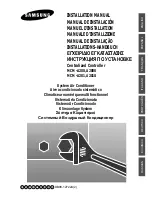
Refrigeration Maintenance
10-3
EVACUATION, DEHYDRATION, AND CHARGING
Evacuation is Important and is Critical to System Performance!
It has been determined through testing and system analysis that refrigeration systems which contain non-condensables such as
nitrogen and/or air can be overcharged with refrigerant when charged using the sight glass method. An overcharge of refrigerant
will cause high system pressures, system shutdowns, and compressor damage. Moisture in the system will produce acid and other
contaminants that lead to compressor failure.
Therefore, Thermo King recommends that all repairs to the refrigeration system include the removal and reclamation
(cleaning) of the refrigerant, followed by a thorough evacuation using the proper tools and procedures.
The primary objective of evacuation is to bring the system’s pressure into a vacuum to ensure the removal of
non-condensables. The objective of dehydration is to bring the system into a very deep vacuum, below 1,000 microns, to remove
moisture. There are however, certain other principles which must be observed. These are:
• Evacuate from 3-points, suction service valve, discharge service valve, and receiver tank outlet to access both sides of check
valves and solenoids.
• Always leave service valve caps on during evacuation and do not exercise the valve stems while the unit is in a deep vacuum.
Packing glands are prone to leak.
• Never attempt evacuation without a micron vacuum gauge. The micron gauge will help determine:
a.
If the pump is capable of pulling a deep vacuum.
b. When the vacuum pump oil is contaminated.
c.
If the vacuum hoses and valves are leak free.
d. If the unit is leak free.
e.
How long you should evacuate the unit.
f.
That the unit is still in a deep vacuum before any lines are disconnected or refrigerant is added.
NOTE: The attached evacuation procedures have been written to be used with the Thermo King Evacuation System (P/N
204-725). However, the principles of 3-point evacuation and the use of a micron gauge during evacuation should always be
practiced and can be applied when using normal workshop evacuation and micron gauge equipment.
See the diagram of the Thermo King Evacuation Station (Figure on page 10-4) and note the location of the valves and other
components.
Valve #1 (V-1):
Is in the open position when the pump is running to evacuate the hoses and/or the unit. When V-1 is closed, the
pump has been isolated from the hoses and/or the unit.
Valve #2 (V-2):
Is in the open position during unit evacuation. In the closed position, V-2 isolates the micron gauge and
thermistor assembly from the hoses and/or the unit.
Valve #3 (V-3):
Is in the open position during unit evacuation. When closed, V-3 isolates the micron gauge and the vacuum
pump from the other evacuation hoses.
Valve #4 (V-4):
Is in the open position during unit evacuation. When closed, V-4 isolates the evacuation hoses and the unit from
the evacuation system.
Iso-Valve
™
:
Is in the open position when the vacuum pump is running to evacuate the hoses and/or the unit. When Iso-Valve
is closed, the pump has been isolated from the hoses and/or the unit. The Iso-Valve is normally not used because V-1 performs
the same function and is more wear resistant.
Содержание T-1000R
Страница 14: ...Safety Precautions 2 6 Warning Decals 2e24151g0 ...
Страница 18: ...Specifications 3 4 ENGINE CLUTCH Engagement 600 100 RPM Dynamic Torque 66 fT lb 89 5 N m minimum 1600 RPM ...
Страница 34: ...Maintenance Inspection Schedule 4 10 ...
Страница 57: ...Unit Description 5 23 Purge Mode UT Series 1 3 4 5 2 ...
Страница 67: ...Unit Description 5 33 Zone 1 Cool and Zone 2 Cool UT SPECTRUM Units ...
Страница 69: ...Unit Description 5 35 Purge Mode UT SPECTRUM Units ...
Страница 71: ...Unit Description 5 37 Zone 1 Cool and Zone 2 Heat UT SPECTRUM Units ...
Страница 72: ...Unit Description 5 38 ...
Страница 74: ...Diesel Electric Menu 6 28 Adjust Brightness 6 29 Time 6 30 ...
Страница 120: ...Operating Instructions Standard HMI 7 18 ...
Страница 152: ...Engine Maintenance 9 14 T Series Fuel and Oil System Components TK 376 ...
Страница 154: ...Engine Maintenance 9 16 T Series Fuel and Oil System Components TK 270 ...
Страница 156: ...Engine Maintenance 9 18 UT Series Fuel System Components AMA768 ...
Страница 172: ...Engine Maintenance 9 34 T Series Engine Mounting Components for 2 Cylinder Engine ...
Страница 184: ...Engine Maintenance 9 46 ...
Страница 238: ...Refrigeration Maintenance 10 54 ...
Страница 246: ...Clutch Maintenance 11 8 ...
Страница 258: ...Structural Maintenance 12 12 ...
Страница 264: ...Mechanical Diagnosis 13 6 ...
Страница 265: ...14 Electric Standby Diagnosis ...
Страница 268: ...Electric Standby Diagnosis 14 4 ...
Страница 269: ...15 Refrigeration System Diagnosis ...
Страница 272: ...Refrigeration System Diagnosis 15 4 ...
Страница 280: ...Remote Evaporators 16 8 ...
Страница 282: ...Wiring Diagrams and Wiring Schematics 17 2 ...
















































